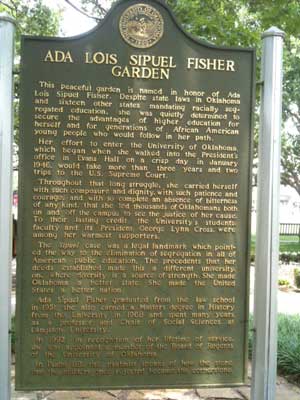Our [Silenced] History: Ada Lois Sipuel Fisher
In 1949, Ada Lois Sipuel was admitted to the University of Oklahoma Law School and became the first African American to graduate in 1951. She was only admitted after the U.S. Supreme Court heard her case and decided against the Oklahoma Board of Regents. In an attempt to celebrate this success, the Ada Lois Sipuel Fisher Garden on the OU campus was dedicated soon after Fisher’s death in October of 1995 (Hall, 2007). The plaque in the garden mentions nothing about the treatment Fisher endured during her time here at the University of Oklahoma: “colored” seating, separated by chains from her classmates, forced to enter the cafeteria through a back door only to sit once again in segregated seating, etc. No, the plaque says only that whatever the treatment was, Fisher handled it “with such composure and dignity, with such patience and courage, and with [a] complete absence of bitterness of any kind." However, Fisher (1996) writes of her time:

In all the time that I was there, I never quite escaped a feeling of isolation. The faculty was always fair, and my fellow students were generally friendly. Still, I felt that I was being observed across campus . . . watching to see if I succeeded as a student. Some persons honestly questioned the ability of blacks to cope and advance in a white academic arena…. Sitting in the large, unadorned rooms of Monnet Hall, I was alone. Law school is strenuous. It was more strenuous with the reality of aloneness. Sometimes I would go into an empty classroom to study. When the rooms were empty, I always sat in one of the front seats. As time for class approached and other students arrived, I would gather my notes and books and climb the rows up to the 'colored' seat. (p. 147)
In fact, Fisher (1996) claimed that of all the racist experiences she had during her life, the one that was most hurtful, most humiliating, was walking past her white classmates to her “colored” seat at the back of the room, being watched by one hundred pairs of eyes as she struggled not to let herself, or her carefully guarded demeanor, stumble (p. 148).
It can be argued that this sort of rhetoric on the commemorative plaque is a greater offense than the mistreatment that Sipuel faced during her time here. It redefines her place in OU history by highlighting her struggle as something glorious rather than arduous and inhumane. It also depicts OU, and its faculty, staff, and students, as a welcoming community rather than the isolating institution that it was. According to Fisher's book, many of the white students were friendly and she had good relationships with all of her professors. However, the hardest part about being at OU was that even if people were not overtly cruel, they either did not or could not do anything to stop the segregation and the feelings of isolation felt by Fisher, which perhaps was worse than if they had all been overtly hateful towards her. Why did President Cross not order the lone "colored" desk removed? Or why were no protests held on Fisher's behalf, as they were against Little Red a couple of decades later?
Narratives such as the one on this plaque whitewash historical race struggles and create an environment at OU where white university community members can look back at the comfortable progress "we" have made. The University of Oklahoma was founded as an all-white institution. That history is clear and evident from the many pictures from the University’s first years that include no persons of color, as well as historical texts from the university and the history of the state. This history continues to affect the institutional fabric of OU and the way that the student body, faculty, and staff talk - and don't talk - about race.
The full text of the plaque reads:
This peaceful garden is named in honor of Ada Lois Sipuel Fisher. Despite state laws in Oklahoma and sixteen other states mandating racially segregated education, she was quietly determined to secure the advantages of higher education for herself and for generations of African American young people who would follow in her path.
Her effort to enter the University of Oklahoma, which began when she walked into the President's office in Evans Hall on a crisp day in January 1946, would take more than three years and two trips to the U.S. Supreme Court.
Throughout that long struggle, she carried herself with such composure and dignity, with such patience and courage, and with so complete an absence of bitterness of any kind, that she led thousands of Oklahomans both on and off the campus to see the justice of her cause. To their lasting credit, the University's students, faculty and its President, George Lynn Cross, were among her warmest supporters.
The Sipuel case was a legal landmark which pointed the way to the elimination of segregation in all of American public education. The precedents that her deeds established made this a different university, one where diversity is a source of strength. She made Oklahoma a better state. She made the United States a better nation.
Ada Sipuel Fisher graduated from the law school in 1951; she also earned a Masters degree in History from the University in 1968 and spent many years as a professor and Chair of Social Sciences at Langston University.
In 1992, in recognition of her lifetime of service, she was appointed a member of the Board of Regents of the University of Oklahoma.
In Psalm 118, the psalmist speaks of how the stone that the builders once rejected became the cornerstone. (University of Oklahoma, ca.1995)